TUI Case Study: Analysis and Evaluation of Innovation Initiatives
VerifiedAdded on 2023/06/07
|10
|3294
|231
Case Study
AI Summary
This case study critically evaluates innovation vignettes within the TUI Group, a German leisure and tourism organization. It analyzes the ineffectiveness of initiatives like general power hours and master classes due to factors such as lack of executive involvement, irrelevant training content, and poor follow-up. The study also examines hackathons and forums, highlighting issues like artificial challenges, lack of cross-functional engagement, and vague marketing goals. Recommendations include implementing structured problem-solving techniques like brainstorming, attribute analysis, and role storming to foster more effective and innovative solutions within the organization. The report emphasizes the importance of practical application, relevant training, and cross-departmental collaboration for successful innovation.
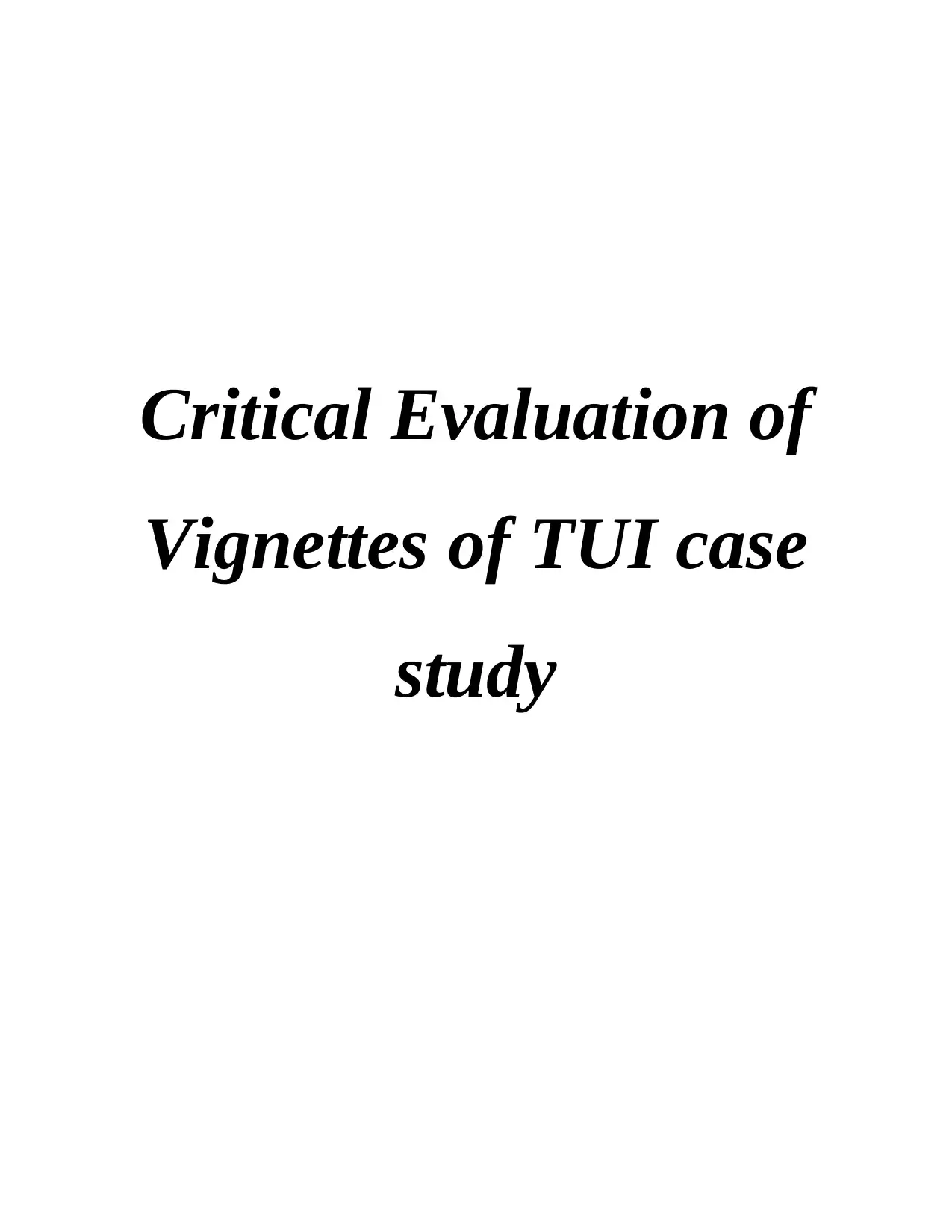
Critical Evaluation of
Vignettes of TUI case
study
Vignettes of TUI case
study
Paraphrase This Document
Need a fresh take? Get an instant paraphrase of this document with our AI Paraphraser
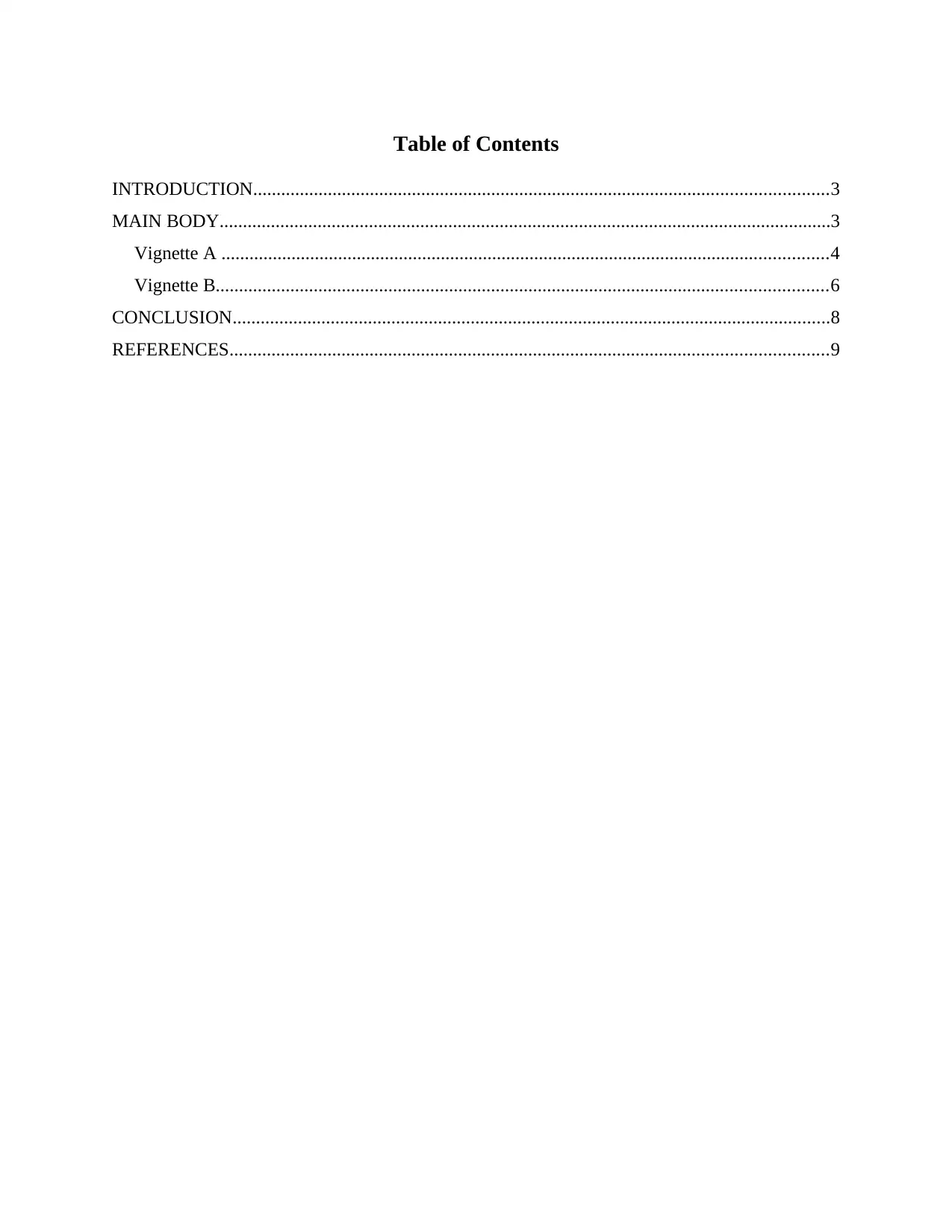
Table of Contents
INTRODUCTION...........................................................................................................................3
MAIN BODY...................................................................................................................................3
Vignette A ..................................................................................................................................4
Vignette B...................................................................................................................................6
CONCLUSION................................................................................................................................8
REFERENCES................................................................................................................................9
INTRODUCTION...........................................................................................................................3
MAIN BODY...................................................................................................................................3
Vignette A ..................................................................................................................................4
Vignette B...................................................................................................................................6
CONCLUSION................................................................................................................................8
REFERENCES................................................................................................................................9
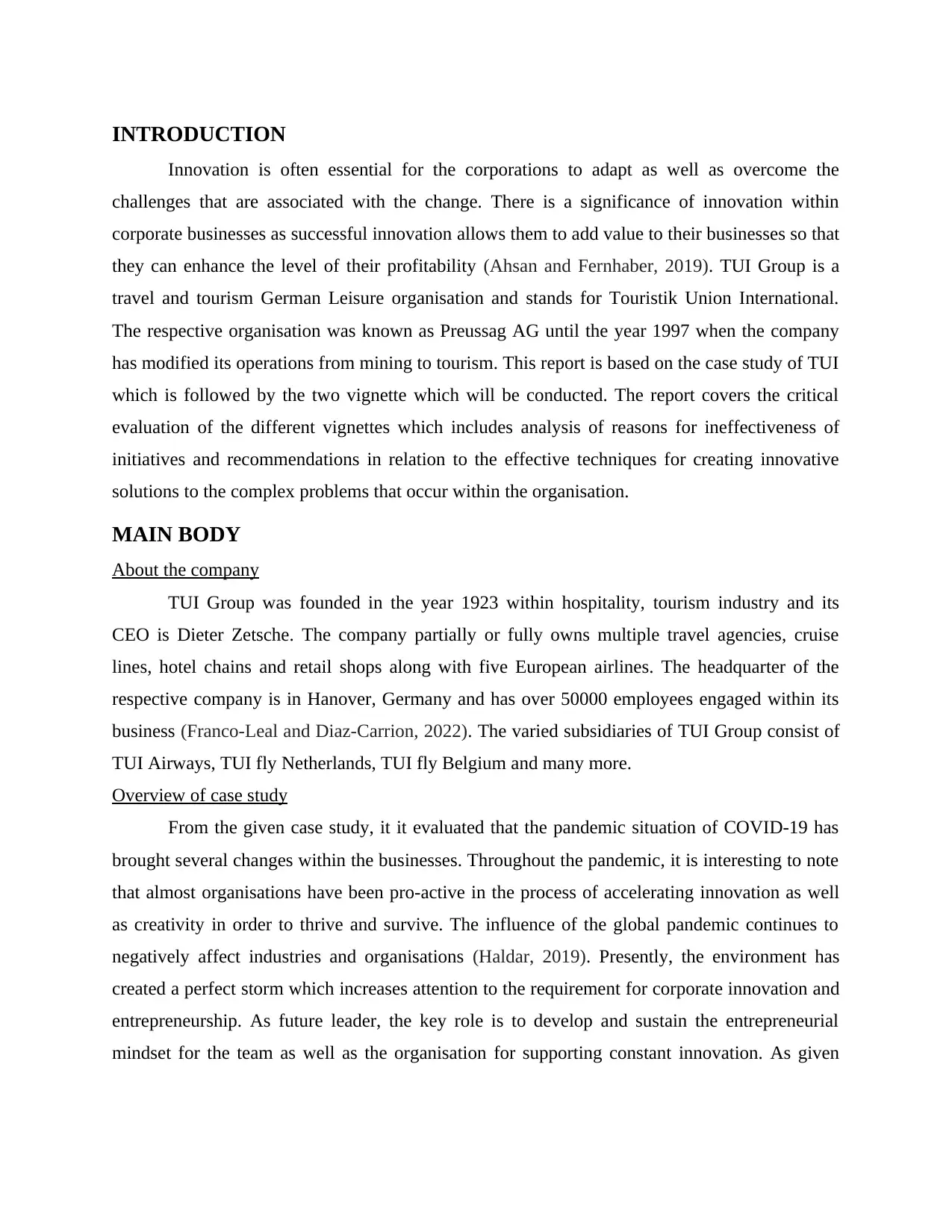
INTRODUCTION
Innovation is often essential for the corporations to adapt as well as overcome the
challenges that are associated with the change. There is a significance of innovation within
corporate businesses as successful innovation allows them to add value to their businesses so that
they can enhance the level of their profitability (Ahsan and Fernhaber, 2019). TUI Group is a
travel and tourism German Leisure organisation and stands for Touristik Union International.
The respective organisation was known as Preussag AG until the year 1997 when the company
has modified its operations from mining to tourism. This report is based on the case study of TUI
which is followed by the two vignette which will be conducted. The report covers the critical
evaluation of the different vignettes which includes analysis of reasons for ineffectiveness of
initiatives and recommendations in relation to the effective techniques for creating innovative
solutions to the complex problems that occur within the organisation.
MAIN BODY
About the company
TUI Group was founded in the year 1923 within hospitality, tourism industry and its
CEO is Dieter Zetsche. The company partially or fully owns multiple travel agencies, cruise
lines, hotel chains and retail shops along with five European airlines. The headquarter of the
respective company is in Hanover, Germany and has over 50000 employees engaged within its
business (Franco-Leal and Diaz-Carrion, 2022). The varied subsidiaries of TUI Group consist of
TUI Airways, TUI fly Netherlands, TUI fly Belgium and many more.
Overview of case study
From the given case study, it it evaluated that the pandemic situation of COVID-19 has
brought several changes within the businesses. Throughout the pandemic, it is interesting to note
that almost organisations have been pro-active in the process of accelerating innovation as well
as creativity in order to thrive and survive. The influence of the global pandemic continues to
negatively affect industries and organisations (Haldar, 2019). Presently, the environment has
created a perfect storm which increases attention to the requirement for corporate innovation and
entrepreneurship. As future leader, the key role is to develop and sustain the entrepreneurial
mindset for the team as well as the organisation for supporting constant innovation. As given
Innovation is often essential for the corporations to adapt as well as overcome the
challenges that are associated with the change. There is a significance of innovation within
corporate businesses as successful innovation allows them to add value to their businesses so that
they can enhance the level of their profitability (Ahsan and Fernhaber, 2019). TUI Group is a
travel and tourism German Leisure organisation and stands for Touristik Union International.
The respective organisation was known as Preussag AG until the year 1997 when the company
has modified its operations from mining to tourism. This report is based on the case study of TUI
which is followed by the two vignette which will be conducted. The report covers the critical
evaluation of the different vignettes which includes analysis of reasons for ineffectiveness of
initiatives and recommendations in relation to the effective techniques for creating innovative
solutions to the complex problems that occur within the organisation.
MAIN BODY
About the company
TUI Group was founded in the year 1923 within hospitality, tourism industry and its
CEO is Dieter Zetsche. The company partially or fully owns multiple travel agencies, cruise
lines, hotel chains and retail shops along with five European airlines. The headquarter of the
respective company is in Hanover, Germany and has over 50000 employees engaged within its
business (Franco-Leal and Diaz-Carrion, 2022). The varied subsidiaries of TUI Group consist of
TUI Airways, TUI fly Netherlands, TUI fly Belgium and many more.
Overview of case study
From the given case study, it it evaluated that the pandemic situation of COVID-19 has
brought several changes within the businesses. Throughout the pandemic, it is interesting to note
that almost organisations have been pro-active in the process of accelerating innovation as well
as creativity in order to thrive and survive. The influence of the global pandemic continues to
negatively affect industries and organisations (Haldar, 2019). Presently, the environment has
created a perfect storm which increases attention to the requirement for corporate innovation and
entrepreneurship. As future leader, the key role is to develop and sustain the entrepreneurial
mindset for the team as well as the organisation for supporting constant innovation. As given
⊘ This is a preview!⊘
Do you want full access?
Subscribe today to unlock all pages.

Trusted by 1+ million students worldwide
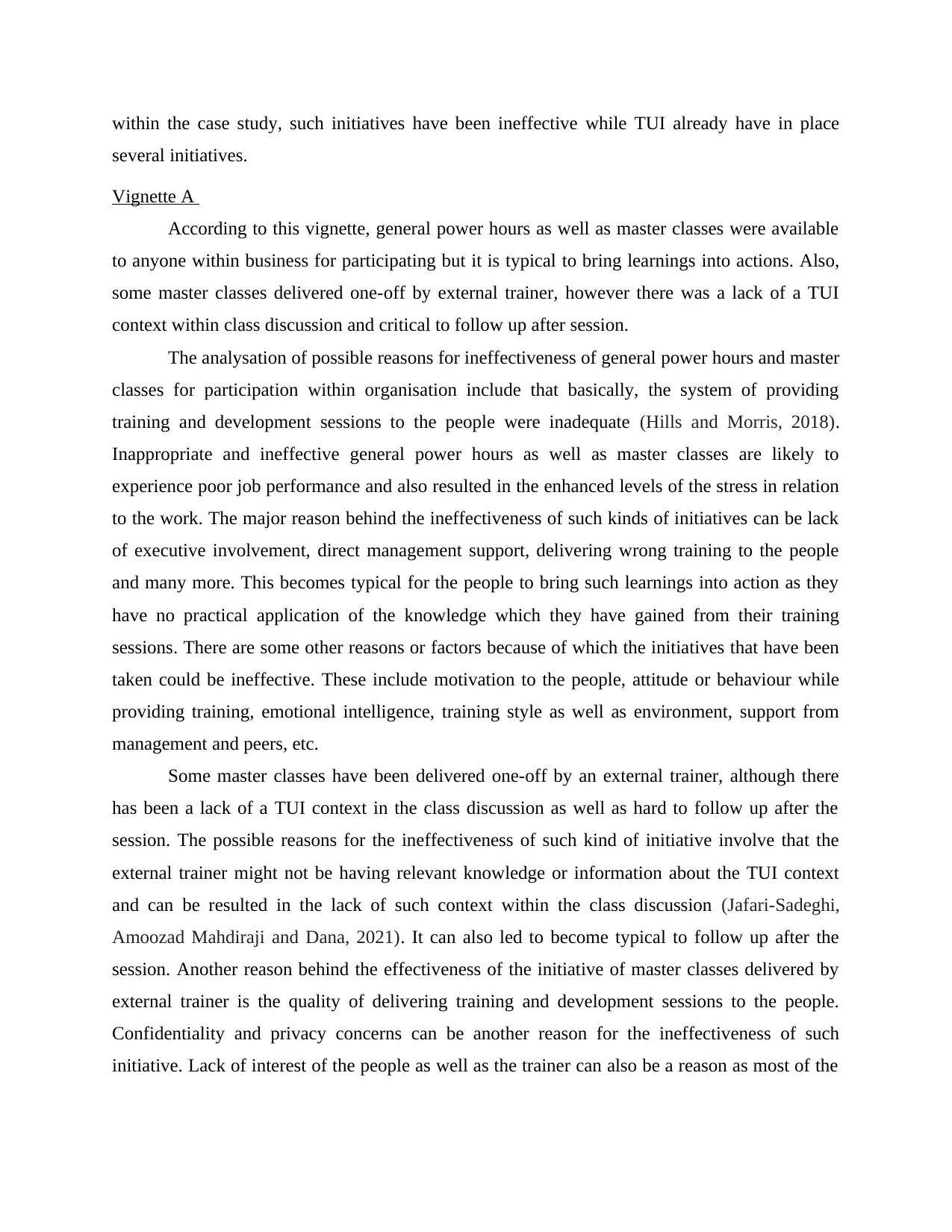
within the case study, such initiatives have been ineffective while TUI already have in place
several initiatives.
Vignette A
According to this vignette, general power hours as well as master classes were available
to anyone within business for participating but it is typical to bring learnings into actions. Also,
some master classes delivered one-off by external trainer, however there was a lack of a TUI
context within class discussion and critical to follow up after session.
The analysation of possible reasons for ineffectiveness of general power hours and master
classes for participation within organisation include that basically, the system of providing
training and development sessions to the people were inadequate (Hills and Morris, 2018).
Inappropriate and ineffective general power hours as well as master classes are likely to
experience poor job performance and also resulted in the enhanced levels of the stress in relation
to the work. The major reason behind the ineffectiveness of such kinds of initiatives can be lack
of executive involvement, direct management support, delivering wrong training to the people
and many more. This becomes typical for the people to bring such learnings into action as they
have no practical application of the knowledge which they have gained from their training
sessions. There are some other reasons or factors because of which the initiatives that have been
taken could be ineffective. These include motivation to the people, attitude or behaviour while
providing training, emotional intelligence, training style as well as environment, support from
management and peers, etc.
Some master classes have been delivered one-off by an external trainer, although there
has been a lack of a TUI context in the class discussion as well as hard to follow up after the
session. The possible reasons for the ineffectiveness of such kind of initiative involve that the
external trainer might not be having relevant knowledge or information about the TUI context
and can be resulted in the lack of such context within the class discussion (Jafari-Sadeghi,
Amoozad Mahdiraji and Dana, 2021). It can also led to become typical to follow up after the
session. Another reason behind the effectiveness of the initiative of master classes delivered by
external trainer is the quality of delivering training and development sessions to the people.
Confidentiality and privacy concerns can be another reason for the ineffectiveness of such
initiative. Lack of interest of the people as well as the trainer can also be a reason as most of the
several initiatives.
Vignette A
According to this vignette, general power hours as well as master classes were available
to anyone within business for participating but it is typical to bring learnings into actions. Also,
some master classes delivered one-off by external trainer, however there was a lack of a TUI
context within class discussion and critical to follow up after session.
The analysation of possible reasons for ineffectiveness of general power hours and master
classes for participation within organisation include that basically, the system of providing
training and development sessions to the people were inadequate (Hills and Morris, 2018).
Inappropriate and ineffective general power hours as well as master classes are likely to
experience poor job performance and also resulted in the enhanced levels of the stress in relation
to the work. The major reason behind the ineffectiveness of such kinds of initiatives can be lack
of executive involvement, direct management support, delivering wrong training to the people
and many more. This becomes typical for the people to bring such learnings into action as they
have no practical application of the knowledge which they have gained from their training
sessions. There are some other reasons or factors because of which the initiatives that have been
taken could be ineffective. These include motivation to the people, attitude or behaviour while
providing training, emotional intelligence, training style as well as environment, support from
management and peers, etc.
Some master classes have been delivered one-off by an external trainer, although there
has been a lack of a TUI context in the class discussion as well as hard to follow up after the
session. The possible reasons for the ineffectiveness of such kind of initiative involve that the
external trainer might not be having relevant knowledge or information about the TUI context
and can be resulted in the lack of such context within the class discussion (Jafari-Sadeghi,
Amoozad Mahdiraji and Dana, 2021). It can also led to become typical to follow up after the
session. Another reason behind the effectiveness of the initiative of master classes delivered by
external trainer is the quality of delivering training and development sessions to the people.
Confidentiality and privacy concerns can be another reason for the ineffectiveness of such
initiative. Lack of interest of the people as well as the trainer can also be a reason as most of the
Paraphrase This Document
Need a fresh take? Get an instant paraphrase of this document with our AI Paraphraser
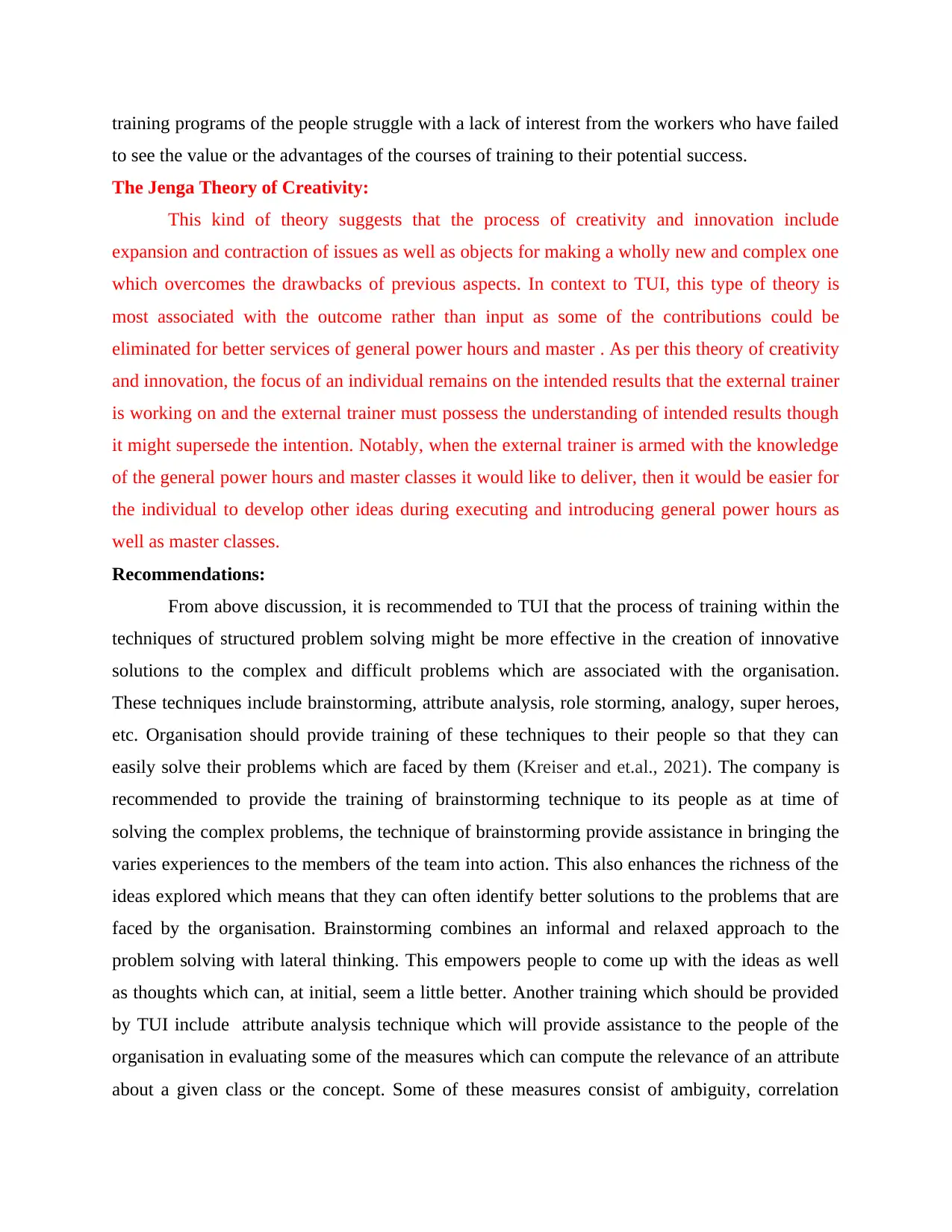
training programs of the people struggle with a lack of interest from the workers who have failed
to see the value or the advantages of the courses of training to their potential success.
The Jenga Theory of Creativity:
This kind of theory suggests that the process of creativity and innovation include
expansion and contraction of issues as well as objects for making a wholly new and complex one
which overcomes the drawbacks of previous aspects. In context to TUI, this type of theory is
most associated with the outcome rather than input as some of the contributions could be
eliminated for better services of general power hours and master . As per this theory of creativity
and innovation, the focus of an individual remains on the intended results that the external trainer
is working on and the external trainer must possess the understanding of intended results though
it might supersede the intention. Notably, when the external trainer is armed with the knowledge
of the general power hours and master classes it would like to deliver, then it would be easier for
the individual to develop other ideas during executing and introducing general power hours as
well as master classes.
Recommendations:
From above discussion, it is recommended to TUI that the process of training within the
techniques of structured problem solving might be more effective in the creation of innovative
solutions to the complex and difficult problems which are associated with the organisation.
These techniques include brainstorming, attribute analysis, role storming, analogy, super heroes,
etc. Organisation should provide training of these techniques to their people so that they can
easily solve their problems which are faced by them (Kreiser and et.al., 2021). The company is
recommended to provide the training of brainstorming technique to its people as at time of
solving the complex problems, the technique of brainstorming provide assistance in bringing the
varies experiences to the members of the team into action. This also enhances the richness of the
ideas explored which means that they can often identify better solutions to the problems that are
faced by the organisation. Brainstorming combines an informal and relaxed approach to the
problem solving with lateral thinking. This empowers people to come up with the ideas as well
as thoughts which can, at initial, seem a little better. Another training which should be provided
by TUI include attribute analysis technique which will provide assistance to the people of the
organisation in evaluating some of the measures which can compute the relevance of an attribute
about a given class or the concept. Some of these measures consist of ambiguity, correlation
to see the value or the advantages of the courses of training to their potential success.
The Jenga Theory of Creativity:
This kind of theory suggests that the process of creativity and innovation include
expansion and contraction of issues as well as objects for making a wholly new and complex one
which overcomes the drawbacks of previous aspects. In context to TUI, this type of theory is
most associated with the outcome rather than input as some of the contributions could be
eliminated for better services of general power hours and master . As per this theory of creativity
and innovation, the focus of an individual remains on the intended results that the external trainer
is working on and the external trainer must possess the understanding of intended results though
it might supersede the intention. Notably, when the external trainer is armed with the knowledge
of the general power hours and master classes it would like to deliver, then it would be easier for
the individual to develop other ideas during executing and introducing general power hours as
well as master classes.
Recommendations:
From above discussion, it is recommended to TUI that the process of training within the
techniques of structured problem solving might be more effective in the creation of innovative
solutions to the complex and difficult problems which are associated with the organisation.
These techniques include brainstorming, attribute analysis, role storming, analogy, super heroes,
etc. Organisation should provide training of these techniques to their people so that they can
easily solve their problems which are faced by them (Kreiser and et.al., 2021). The company is
recommended to provide the training of brainstorming technique to its people as at time of
solving the complex problems, the technique of brainstorming provide assistance in bringing the
varies experiences to the members of the team into action. This also enhances the richness of the
ideas explored which means that they can often identify better solutions to the problems that are
faced by the organisation. Brainstorming combines an informal and relaxed approach to the
problem solving with lateral thinking. This empowers people to come up with the ideas as well
as thoughts which can, at initial, seem a little better. Another training which should be provided
by TUI include attribute analysis technique which will provide assistance to the people of the
organisation in evaluating some of the measures which can compute the relevance of an attribute
about a given class or the concept. Some of these measures consist of ambiguity, correlation
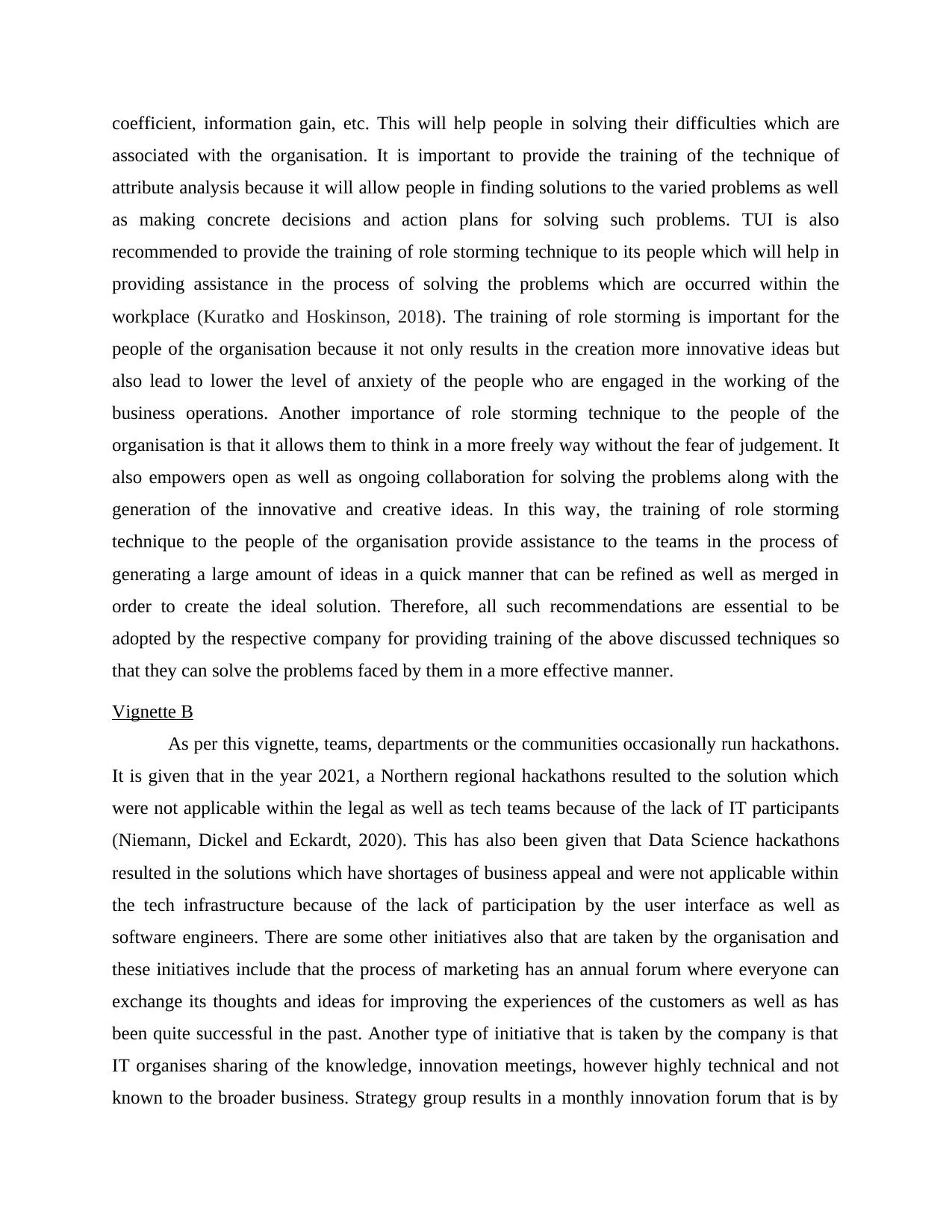
coefficient, information gain, etc. This will help people in solving their difficulties which are
associated with the organisation. It is important to provide the training of the technique of
attribute analysis because it will allow people in finding solutions to the varied problems as well
as making concrete decisions and action plans for solving such problems. TUI is also
recommended to provide the training of role storming technique to its people which will help in
providing assistance in the process of solving the problems which are occurred within the
workplace (Kuratko and Hoskinson, 2018). The training of role storming is important for the
people of the organisation because it not only results in the creation more innovative ideas but
also lead to lower the level of anxiety of the people who are engaged in the working of the
business operations. Another importance of role storming technique to the people of the
organisation is that it allows them to think in a more freely way without the fear of judgement. It
also empowers open as well as ongoing collaboration for solving the problems along with the
generation of the innovative and creative ideas. In this way, the training of role storming
technique to the people of the organisation provide assistance to the teams in the process of
generating a large amount of ideas in a quick manner that can be refined as well as merged in
order to create the ideal solution. Therefore, all such recommendations are essential to be
adopted by the respective company for providing training of the above discussed techniques so
that they can solve the problems faced by them in a more effective manner.
Vignette B
As per this vignette, teams, departments or the communities occasionally run hackathons.
It is given that in the year 2021, a Northern regional hackathons resulted to the solution which
were not applicable within the legal as well as tech teams because of the lack of IT participants
(Niemann, Dickel and Eckardt, 2020). This has also been given that Data Science hackathons
resulted in the solutions which have shortages of business appeal and were not applicable within
the tech infrastructure because of the lack of participation by the user interface as well as
software engineers. There are some other initiatives also that are taken by the organisation and
these initiatives include that the process of marketing has an annual forum where everyone can
exchange its thoughts and ideas for improving the experiences of the customers as well as has
been quite successful in the past. Another type of initiative that is taken by the company is that
IT organises sharing of the knowledge, innovation meetings, however highly technical and not
known to the broader business. Strategy group results in a monthly innovation forum that is by
associated with the organisation. It is important to provide the training of the technique of
attribute analysis because it will allow people in finding solutions to the varied problems as well
as making concrete decisions and action plans for solving such problems. TUI is also
recommended to provide the training of role storming technique to its people which will help in
providing assistance in the process of solving the problems which are occurred within the
workplace (Kuratko and Hoskinson, 2018). The training of role storming is important for the
people of the organisation because it not only results in the creation more innovative ideas but
also lead to lower the level of anxiety of the people who are engaged in the working of the
business operations. Another importance of role storming technique to the people of the
organisation is that it allows them to think in a more freely way without the fear of judgement. It
also empowers open as well as ongoing collaboration for solving the problems along with the
generation of the innovative and creative ideas. In this way, the training of role storming
technique to the people of the organisation provide assistance to the teams in the process of
generating a large amount of ideas in a quick manner that can be refined as well as merged in
order to create the ideal solution. Therefore, all such recommendations are essential to be
adopted by the respective company for providing training of the above discussed techniques so
that they can solve the problems faced by them in a more effective manner.
Vignette B
As per this vignette, teams, departments or the communities occasionally run hackathons.
It is given that in the year 2021, a Northern regional hackathons resulted to the solution which
were not applicable within the legal as well as tech teams because of the lack of IT participants
(Niemann, Dickel and Eckardt, 2020). This has also been given that Data Science hackathons
resulted in the solutions which have shortages of business appeal and were not applicable within
the tech infrastructure because of the lack of participation by the user interface as well as
software engineers. There are some other initiatives also that are taken by the organisation and
these initiatives include that the process of marketing has an annual forum where everyone can
exchange its thoughts and ideas for improving the experiences of the customers as well as has
been quite successful in the past. Another type of initiative that is taken by the company is that
IT organises sharing of the knowledge, innovation meetings, however highly technical and not
known to the broader business. Strategy group results in a monthly innovation forum that is by
⊘ This is a preview!⊘
Do you want full access?
Subscribe today to unlock all pages.

Trusted by 1+ million students worldwide
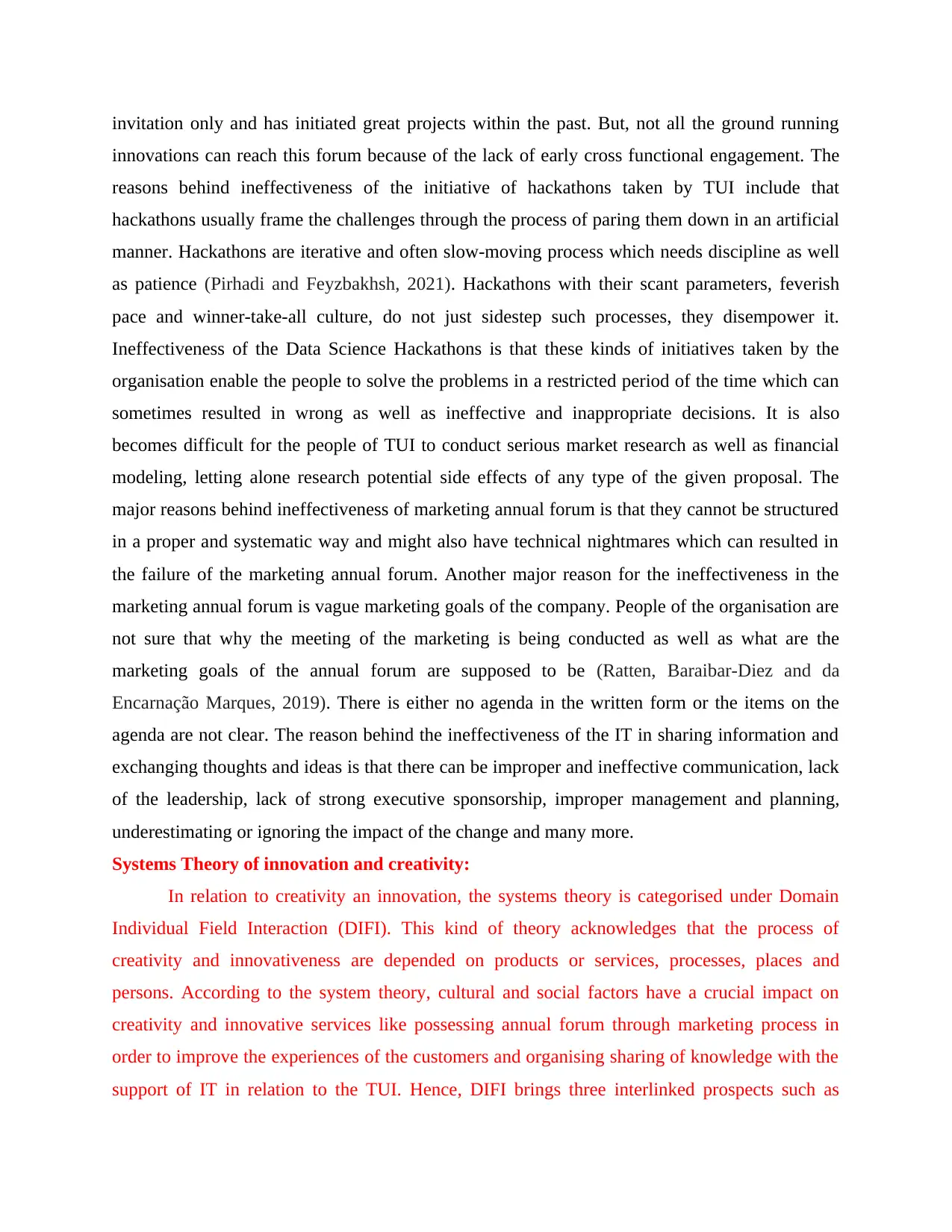
invitation only and has initiated great projects within the past. But, not all the ground running
innovations can reach this forum because of the lack of early cross functional engagement. The
reasons behind ineffectiveness of the initiative of hackathons taken by TUI include that
hackathons usually frame the challenges through the process of paring them down in an artificial
manner. Hackathons are iterative and often slow-moving process which needs discipline as well
as patience (Pirhadi and Feyzbakhsh, 2021). Hackathons with their scant parameters, feverish
pace and winner-take-all culture, do not just sidestep such processes, they disempower it.
Ineffectiveness of the Data Science Hackathons is that these kinds of initiatives taken by the
organisation enable the people to solve the problems in a restricted period of the time which can
sometimes resulted in wrong as well as ineffective and inappropriate decisions. It is also
becomes difficult for the people of TUI to conduct serious market research as well as financial
modeling, letting alone research potential side effects of any type of the given proposal. The
major reasons behind ineffectiveness of marketing annual forum is that they cannot be structured
in a proper and systematic way and might also have technical nightmares which can resulted in
the failure of the marketing annual forum. Another major reason for the ineffectiveness in the
marketing annual forum is vague marketing goals of the company. People of the organisation are
not sure that why the meeting of the marketing is being conducted as well as what are the
marketing goals of the annual forum are supposed to be (Ratten, Baraibar-Diez and da
Encarnação Marques, 2019). There is either no agenda in the written form or the items on the
agenda are not clear. The reason behind the ineffectiveness of the IT in sharing information and
exchanging thoughts and ideas is that there can be improper and ineffective communication, lack
of the leadership, lack of strong executive sponsorship, improper management and planning,
underestimating or ignoring the impact of the change and many more.
Systems Theory of innovation and creativity:
In relation to creativity an innovation, the systems theory is categorised under Domain
Individual Field Interaction (DIFI). This kind of theory acknowledges that the process of
creativity and innovativeness are depended on products or services, processes, places and
persons. According to the system theory, cultural and social factors have a crucial impact on
creativity and innovative services like possessing annual forum through marketing process in
order to improve the experiences of the customers and organising sharing of knowledge with the
support of IT in relation to the TUI. Hence, DIFI brings three interlinked prospects such as
innovations can reach this forum because of the lack of early cross functional engagement. The
reasons behind ineffectiveness of the initiative of hackathons taken by TUI include that
hackathons usually frame the challenges through the process of paring them down in an artificial
manner. Hackathons are iterative and often slow-moving process which needs discipline as well
as patience (Pirhadi and Feyzbakhsh, 2021). Hackathons with their scant parameters, feverish
pace and winner-take-all culture, do not just sidestep such processes, they disempower it.
Ineffectiveness of the Data Science Hackathons is that these kinds of initiatives taken by the
organisation enable the people to solve the problems in a restricted period of the time which can
sometimes resulted in wrong as well as ineffective and inappropriate decisions. It is also
becomes difficult for the people of TUI to conduct serious market research as well as financial
modeling, letting alone research potential side effects of any type of the given proposal. The
major reasons behind ineffectiveness of marketing annual forum is that they cannot be structured
in a proper and systematic way and might also have technical nightmares which can resulted in
the failure of the marketing annual forum. Another major reason for the ineffectiveness in the
marketing annual forum is vague marketing goals of the company. People of the organisation are
not sure that why the meeting of the marketing is being conducted as well as what are the
marketing goals of the annual forum are supposed to be (Ratten, Baraibar-Diez and da
Encarnação Marques, 2019). There is either no agenda in the written form or the items on the
agenda are not clear. The reason behind the ineffectiveness of the IT in sharing information and
exchanging thoughts and ideas is that there can be improper and ineffective communication, lack
of the leadership, lack of strong executive sponsorship, improper management and planning,
underestimating or ignoring the impact of the change and many more.
Systems Theory of innovation and creativity:
In relation to creativity an innovation, the systems theory is categorised under Domain
Individual Field Interaction (DIFI). This kind of theory acknowledges that the process of
creativity and innovativeness are depended on products or services, processes, places and
persons. According to the system theory, cultural and social factors have a crucial impact on
creativity and innovative services like possessing annual forum through marketing process in
order to improve the experiences of the customers and organising sharing of knowledge with the
support of IT in relation to the TUI. Hence, DIFI brings three interlinked prospects such as
Paraphrase This Document
Need a fresh take? Get an instant paraphrase of this document with our AI Paraphraser

person, domain and field that assists creativity. Comprehensively, they bring modifications to the
business of TUI context and states how management initiate changes of conducting annual forum
through marketing process as well as organising sharing of the knowledge by IT in context to
TUI.
Recommendations:
From the above discussion, it is recommended to the management of TUI that the
company must adopt systematic approaches for the purpose of creating innovative solutions to
the difficult problems that are faced by company through making use of the approaches such as
design thinking, CPS, etc. The administration of the organisation is recommended to give
knowledge to its people about the CPS which stands for Creative problem solving and design
thinking so that they may get able to create innovative solutions to the complex problems that are
faced by the organisation. The significance of CPS in creating innovative solutions is that it helps
in encouraging the people of the business in the process of identifying fresh perspectives as well
as come up with the innovative solutions. This will provide assistance to them in the process of
formulating a plan in order to overcome the problems as well as reaching out to the goals of the
organisation (Yunis, Tarhini and Kassar, 2018). TUI is also recommended to provide excellent
customer services and experiences through first understanding the needs and perceptions, the
experiences as well as pain points of the market share with the support of marketing process.
TUI is recommended to use CPS because it is the key point of control over major process
scheduling infrastructure gets designed for both the business users as well as administrators.
Users of the business schedule, submit and control all the jobs within the workplace while
administrators manage SAP, CPS and entire central process scheduling landscape. The
significance of the design thinking in the process of creating innovative solutions is that it
prioritises the needs of the customers above everything else. This also facilitates in involving a
person within the various opportunities such as eating a prototype and experimenting, gathering
feedback from market-base and redesigning processes and strategies using innovative solutions.
CONCLUSION
From above explanation of the report, it has been concluded that the process of creativity
and innovation plays a significant role in a corporate business. These provide assistance to the
entrepreneurs in developing new approaches and ways of in relation to improve existing
processes and strategies in order to optimise the business. This report has been based on the case
business of TUI context and states how management initiate changes of conducting annual forum
through marketing process as well as organising sharing of the knowledge by IT in context to
TUI.
Recommendations:
From the above discussion, it is recommended to the management of TUI that the
company must adopt systematic approaches for the purpose of creating innovative solutions to
the difficult problems that are faced by company through making use of the approaches such as
design thinking, CPS, etc. The administration of the organisation is recommended to give
knowledge to its people about the CPS which stands for Creative problem solving and design
thinking so that they may get able to create innovative solutions to the complex problems that are
faced by the organisation. The significance of CPS in creating innovative solutions is that it helps
in encouraging the people of the business in the process of identifying fresh perspectives as well
as come up with the innovative solutions. This will provide assistance to them in the process of
formulating a plan in order to overcome the problems as well as reaching out to the goals of the
organisation (Yunis, Tarhini and Kassar, 2018). TUI is also recommended to provide excellent
customer services and experiences through first understanding the needs and perceptions, the
experiences as well as pain points of the market share with the support of marketing process.
TUI is recommended to use CPS because it is the key point of control over major process
scheduling infrastructure gets designed for both the business users as well as administrators.
Users of the business schedule, submit and control all the jobs within the workplace while
administrators manage SAP, CPS and entire central process scheduling landscape. The
significance of the design thinking in the process of creating innovative solutions is that it
prioritises the needs of the customers above everything else. This also facilitates in involving a
person within the various opportunities such as eating a prototype and experimenting, gathering
feedback from market-base and redesigning processes and strategies using innovative solutions.
CONCLUSION
From above explanation of the report, it has been concluded that the process of creativity
and innovation plays a significant role in a corporate business. These provide assistance to the
entrepreneurs in developing new approaches and ways of in relation to improve existing
processes and strategies in order to optimise the business. This report has been based on the case
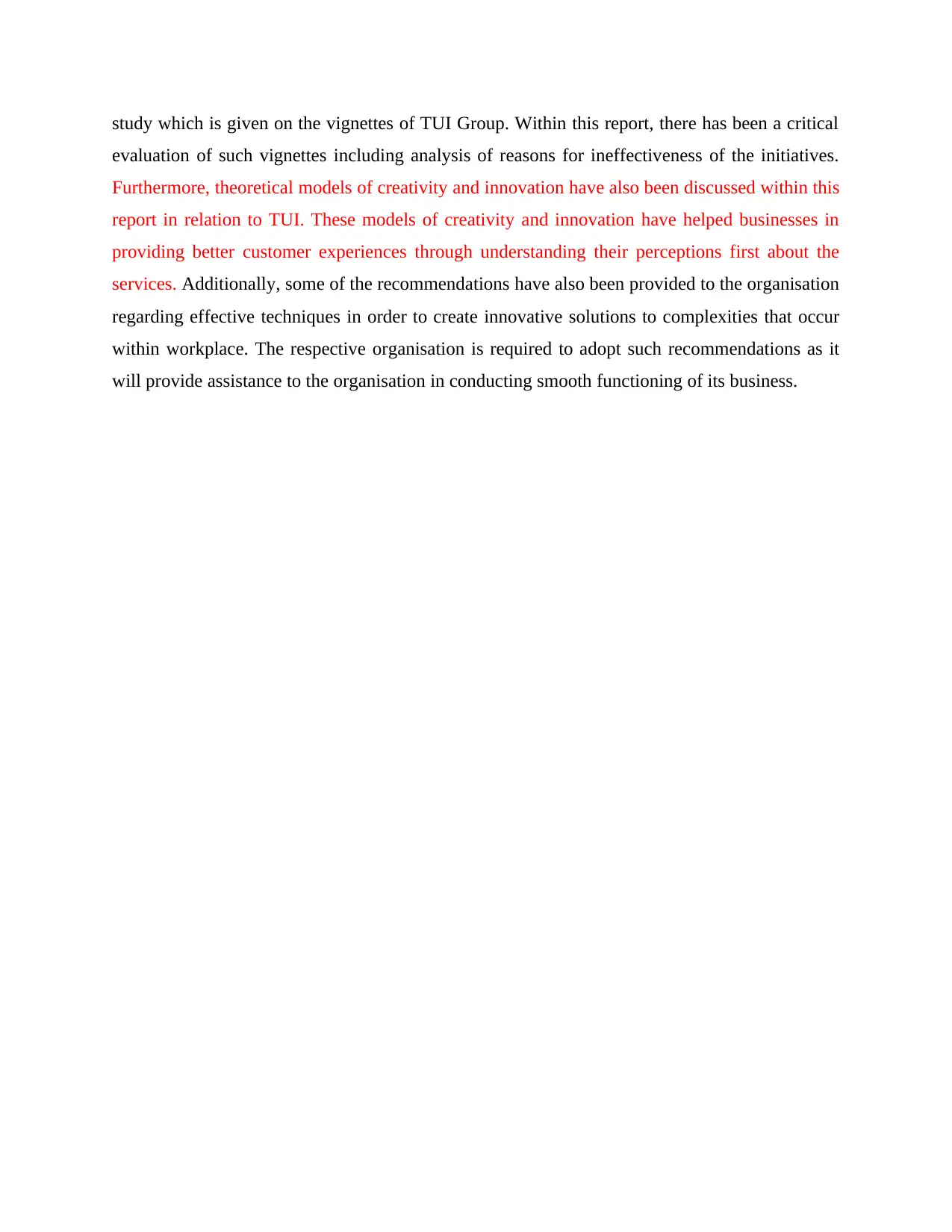
study which is given on the vignettes of TUI Group. Within this report, there has been a critical
evaluation of such vignettes including analysis of reasons for ineffectiveness of the initiatives.
Furthermore, theoretical models of creativity and innovation have also been discussed within this
report in relation to TUI. These models of creativity and innovation have helped businesses in
providing better customer experiences through understanding their perceptions first about the
services. Additionally, some of the recommendations have also been provided to the organisation
regarding effective techniques in order to create innovative solutions to complexities that occur
within workplace. The respective organisation is required to adopt such recommendations as it
will provide assistance to the organisation in conducting smooth functioning of its business.
evaluation of such vignettes including analysis of reasons for ineffectiveness of the initiatives.
Furthermore, theoretical models of creativity and innovation have also been discussed within this
report in relation to TUI. These models of creativity and innovation have helped businesses in
providing better customer experiences through understanding their perceptions first about the
services. Additionally, some of the recommendations have also been provided to the organisation
regarding effective techniques in order to create innovative solutions to complexities that occur
within workplace. The respective organisation is required to adopt such recommendations as it
will provide assistance to the organisation in conducting smooth functioning of its business.
⊘ This is a preview!⊘
Do you want full access?
Subscribe today to unlock all pages.

Trusted by 1+ million students worldwide
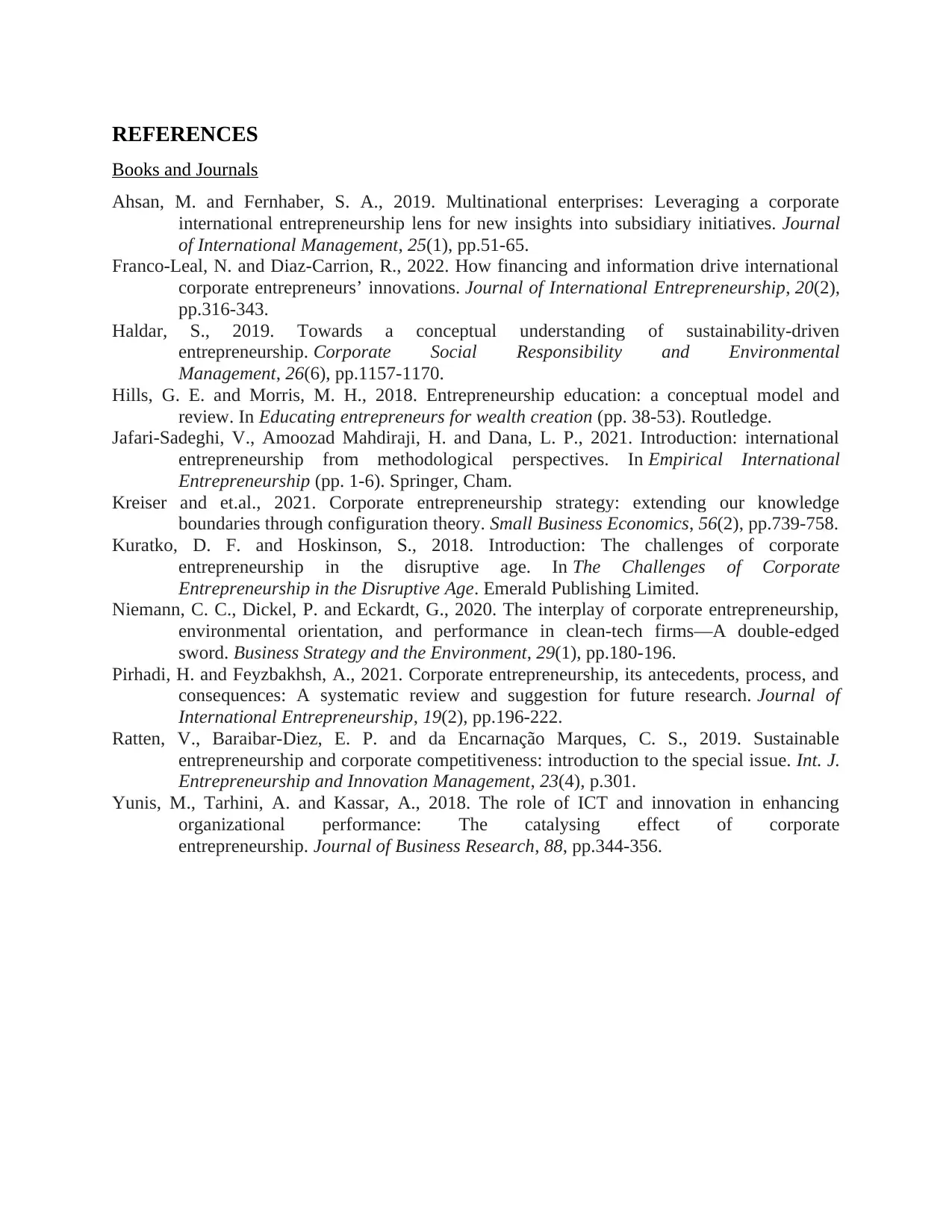
REFERENCES
Books and Journals
Ahsan, M. and Fernhaber, S. A., 2019. Multinational enterprises: Leveraging a corporate
international entrepreneurship lens for new insights into subsidiary initiatives. Journal
of International Management, 25(1), pp.51-65.
Franco-Leal, N. and Diaz-Carrion, R., 2022. How financing and information drive international
corporate entrepreneurs’ innovations. Journal of International Entrepreneurship, 20(2),
pp.316-343.
Haldar, S., 2019. Towards a conceptual understanding of sustainability‐driven
entrepreneurship. Corporate Social Responsibility and Environmental
Management, 26(6), pp.1157-1170.
Hills, G. E. and Morris, M. H., 2018. Entrepreneurship education: a conceptual model and
review. In Educating entrepreneurs for wealth creation (pp. 38-53). Routledge.
Jafari-Sadeghi, V., Amoozad Mahdiraji, H. and Dana, L. P., 2021. Introduction: international
entrepreneurship from methodological perspectives. In Empirical International
Entrepreneurship (pp. 1-6). Springer, Cham.
Kreiser and et.al., 2021. Corporate entrepreneurship strategy: extending our knowledge
boundaries through configuration theory. Small Business Economics, 56(2), pp.739-758.
Kuratko, D. F. and Hoskinson, S., 2018. Introduction: The challenges of corporate
entrepreneurship in the disruptive age. In The Challenges of Corporate
Entrepreneurship in the Disruptive Age. Emerald Publishing Limited.
Niemann, C. C., Dickel, P. and Eckardt, G., 2020. The interplay of corporate entrepreneurship,
environmental orientation, and performance in clean‐tech firms—A double‐edged
sword. Business Strategy and the Environment, 29(1), pp.180-196.
Pirhadi, H. and Feyzbakhsh, A., 2021. Corporate entrepreneurship, its antecedents, process, and
consequences: A systematic review and suggestion for future research. Journal of
International Entrepreneurship, 19(2), pp.196-222.
Ratten, V., Baraibar-Diez, E. P. and da Encarnação Marques, C. S., 2019. Sustainable
entrepreneurship and corporate competitiveness: introduction to the special issue. Int. J.
Entrepreneurship and Innovation Management, 23(4), p.301.
Yunis, M., Tarhini, A. and Kassar, A., 2018. The role of ICT and innovation in enhancing
organizational performance: The catalysing effect of corporate
entrepreneurship. Journal of Business Research, 88, pp.344-356.
Books and Journals
Ahsan, M. and Fernhaber, S. A., 2019. Multinational enterprises: Leveraging a corporate
international entrepreneurship lens for new insights into subsidiary initiatives. Journal
of International Management, 25(1), pp.51-65.
Franco-Leal, N. and Diaz-Carrion, R., 2022. How financing and information drive international
corporate entrepreneurs’ innovations. Journal of International Entrepreneurship, 20(2),
pp.316-343.
Haldar, S., 2019. Towards a conceptual understanding of sustainability‐driven
entrepreneurship. Corporate Social Responsibility and Environmental
Management, 26(6), pp.1157-1170.
Hills, G. E. and Morris, M. H., 2018. Entrepreneurship education: a conceptual model and
review. In Educating entrepreneurs for wealth creation (pp. 38-53). Routledge.
Jafari-Sadeghi, V., Amoozad Mahdiraji, H. and Dana, L. P., 2021. Introduction: international
entrepreneurship from methodological perspectives. In Empirical International
Entrepreneurship (pp. 1-6). Springer, Cham.
Kreiser and et.al., 2021. Corporate entrepreneurship strategy: extending our knowledge
boundaries through configuration theory. Small Business Economics, 56(2), pp.739-758.
Kuratko, D. F. and Hoskinson, S., 2018. Introduction: The challenges of corporate
entrepreneurship in the disruptive age. In The Challenges of Corporate
Entrepreneurship in the Disruptive Age. Emerald Publishing Limited.
Niemann, C. C., Dickel, P. and Eckardt, G., 2020. The interplay of corporate entrepreneurship,
environmental orientation, and performance in clean‐tech firms—A double‐edged
sword. Business Strategy and the Environment, 29(1), pp.180-196.
Pirhadi, H. and Feyzbakhsh, A., 2021. Corporate entrepreneurship, its antecedents, process, and
consequences: A systematic review and suggestion for future research. Journal of
International Entrepreneurship, 19(2), pp.196-222.
Ratten, V., Baraibar-Diez, E. P. and da Encarnação Marques, C. S., 2019. Sustainable
entrepreneurship and corporate competitiveness: introduction to the special issue. Int. J.
Entrepreneurship and Innovation Management, 23(4), p.301.
Yunis, M., Tarhini, A. and Kassar, A., 2018. The role of ICT and innovation in enhancing
organizational performance: The catalysing effect of corporate
entrepreneurship. Journal of Business Research, 88, pp.344-356.
1 out of 10
Related Documents
Your All-in-One AI-Powered Toolkit for Academic Success.
+13062052269
info@desklib.com
Available 24*7 on WhatsApp / Email
![[object Object]](/_next/static/media/star-bottom.7253800d.svg)
Unlock your academic potential
Copyright © 2020–2025 A2Z Services. All Rights Reserved. Developed and managed by ZUCOL.



